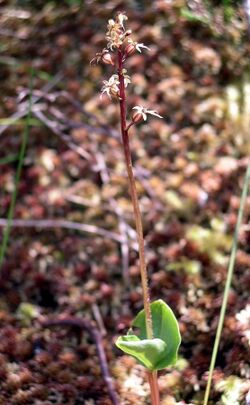Biology:Neottia cordata
| Neottia cordata | |
|---|---|

| |
| Scientific classification | |
| Kingdom: | Plantae |
| Clade: | Tracheophytes |
| Clade: | Angiosperms |
| Clade: | Monocots |
| Order: | Asparagales |
| Family: | Orchidaceae |
| Subfamily: | Epidendroideae |
| Genus: | Neottia |
| Species: | N. cordata
|
| Binomial name | |
| Neottia cordata | |
| Synonyms[1] | |
| |
Neottia cordata, the lesser twayblade[2] or heartleaf twayblade,[3] is an orchid of upland bogs and mires that rarely exceeds 15 cm (5.9 in) in height. It was formerly placed in the genus Listera, but molecular phylogenetic studies have shown that Neottia nidus-avis, the bird's-nest orchid, evolved within the same group.[4]
It is never very common but may be frequently overlooked because of its small size and a tendency to grow underneath heather on sphagnum moss. The single erect flower-stem is often tinged red and is clasped near the base by a pair or ovate-orbicular glossy green leaves. The small flowers which look deceptively simple in structure for an orchid, are purple-green in colour with a somewhat swollen calyx.
Distribution
It has a circumpolar distribution being found in Europe, Asia and large parts of North America. In the United Kingdom its distribution is largely western and northern, becoming most common in the western Highlands of Scotland, Snowdonia in Wales, and the Lake District in England.[5] (Codes) [6]
Ecology
The flowers produce nectar and are pollinated principally by fungus gnats in the groups Mycetophilidae and Sciaridae.[7]
Mycorrhizal partners are almost exclusively fungi in the Sebacinales clade Serendipitaceae. There may also be some association with Ceratobasidiaceae and/or Tulasnellaceae.[7][8]
See also
- Listera ovata
References
- ↑ 1.0 1.1 "Neottia cordata", World Checklist of Selected Plant Families (Royal Botanic Gardens, Kew), http://apps.kew.org/wcsp/namedetail.do?name_id=134197, retrieved 2012-04-04
- ↑ (xls) BSBI List 2007, Botanical Society of Britain and Ireland, https://bsbi.org/download/3542/, retrieved 2014-10-17
- ↑ "Listera cordata". Natural Resources Conservation Service PLANTS Database. USDA. https://plants.usda.gov/core/profile?symbol=LICO6. Retrieved 22 June 2015.
- ↑ Stace, Clive (2010), New Flora of the British Isles (3rd ed.), Cambridge, UK: Cambridge University Press, ISBN 978-0-521-70772-5, p. 864
- ↑ "World Checklist of Selected Plant Families". http://apps.kew.org/wcsp/namedetail.do?name_id=134197.
- ↑ "World Checklist of Selected Plant Families TDWG Geocodes". http://www.nhm.ac.uk/hosted_sites/tdwg/TDWG_geo2.pdf.
- ↑ 7.0 7.1 Kotilínek, Milan; Tatarenko, Irina; Jersáková, Jana (2017-11-30). "Biological Flora of the British Isles:Neottia cordata". Journal of Ecology (Wiley) 106 (1): 444–460. doi:10.1111/1365-2745.12895. ISSN 0022-0477.
- ↑ Molecular Ecology - Two widespread green Neottia species (Orchidaceae) show mycorrhizal preference for Sebacinales in various habitats and ontogenetic stages
External links
Wikidata ☰ Q15502195 entry
 |


